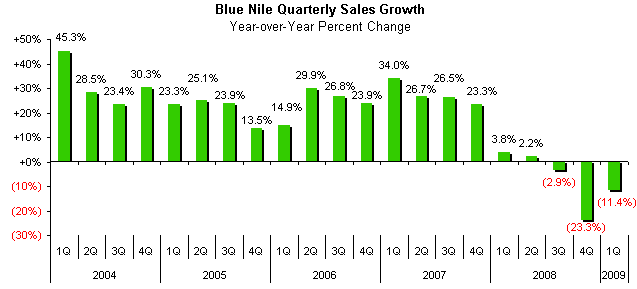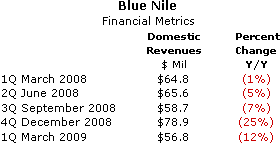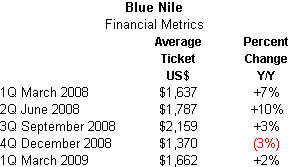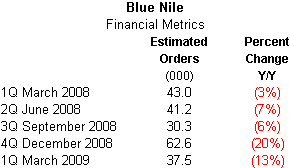IDEX Online Research: Blue Nile Takes Market Share in First Quarter of 2009
May 27, 09
While Blue Nile’s first quarter sales were disappointing – down 11.4 percent – it picked up market share from other specialty jewelers. Overall specialty jewelry industry sales declined by 16 percent in the three-month period ended March 2009. Blue Nile’s domestic (U.S.) sales were down by just over 12 percent, while its international sales were up 19 percent on a constant currency basis, or down a reported 3 percent based on unfavorable currency translation.
While management of Blue Nile did not give a detailed financial outlook for the balance of the year, it did suggest that sales would remain weak in the second and third quarters, but expected that demand would pick up meaningfully in the fourth quarter of 2009.
The following table summarizes key financial metrics from the company’s first quarter period ended March 2009.

Highlights from the company’s first quarter ended March 2009 include the following:
- The bridal category, which includes diamond engagement rings and wedding bands, performed better than the company average. Contrary to erroneous media reports, the number of weddings does not diminish during recessionary times, and Blue Nile felt the tail winds from bridal demand.
- However, high-end engagement rings and jewelry priced above $25,000 at retail were the most affected by the current recessionary environment. Sales of this high-dollar merchandise declined by a greater-than-average amount.
- Management also noted that significant competition came from jewelers who were liquidating their inventories. However, most of this competition was from non-bridal jewelry, since bridal jewelry – mostly diamonds – can be sold at or near full retail, even in a liquidation situation.
- Sales for Blue Nile improved as the quarter progressed. Management previously reported that sales were running down about 15 percent in the period up through Valentine’s Day. Since then, the pace of sales has picked up. Management noted that the seasonally adjusted run-rate for its business picked up in the first quarter versus the fourth quarter of 2008 when sales were down a dismal 23 percent, as the graph below illustrates.

- Blue Nile’s domestic (U.S. market) revenues showed a much smaller decline in the first quarter versus an extremely fourth quarter of 2008. Total U.S. sales were down by only 12 percent, as noted earlier, and the company took market share from traditional store-based jewelers. The table below summarizes the progression of domestic sales for the past five quarters for Blue Nile.
 |
- Blue Nile noted that diamond prices are down, especially in the categories it sells. Prices are down about 20 percent from last year’s peak, and were down 5-10 percent in the first quarter versus the first quarter of 2008. Because Blue Nile essentially buys at prevailing market prices, it can offer great values to its customers when diamond prices are falling. While store-based jewelers – with only a one-time inventory turn – are stuck with high-cost diamonds which they purchased in 2008, Blue Nile is able to buy diamonds at much lower prices and still maintain (or increase) its gross margin.
- While management did not give out an exact average ticket value for its engagement rings, it indicated that it was running slightly below the full-year 2008 average ticket of $6,000.
- Blue Nile’s overall average ticket was $1,662 in the first quarter, up about 1.5 percent from last year. The company’s average ticket by quarter is shown on the table below.
 |
- Blue Nile reported that its total orders were down about 12 percent in the quarter. The table below summarizes its estimated orders by quarter since the beginning of 2008.

- Management announced that it will launch a redesigned website later this year, with enhanced branding and innovative website functionality in important areas such as “Diamond Search” and “Build Your Own Ring.” The newly redesigned website will include enhanced product visualization as well as additional customer-friendly features. The company emphasized that it plans to elevate its branding message. Blue Nile has chosen to make its name the brand message.
- Diane Irvine, Blue Nile’s chief executive officer, said, “While competitors are pulling back on selection and service, we are investing in the customer experience, providing our customers with tremendous value, exceptional quality and selection, and the ability to customize their diamond jewelry and have it delivered in as little as two business days.” Blue Nile is one of the few jewelers who is using the recessionary environment as an opportunity to pick up market share.
- Blue Nile’s gross margin in the first quarter rose to 21.2 percent from last year’s 19.8 percent due to three factors: 1) lower diamond prices; 2) lower precious metals prices; and, 3) better sourcing. These three factors overcame the inherently lower margins on engagement diamond jewelry, a category that grew as a percentage of the total sales mix in 2009. During 2008, engagement rings represented about 69 percent of Blue Nile’s sales, and we believe that at least another 10 percent of sales came from bridal-related categories.
- Blue Nile’s first quarter pretax margin was 4.8 percent, down modestly from last year’s 5.6 percent of sales. Here’s what is so notable about this: most specialty jewelers lose money in the first three quarters of the year; the fourth calendar quarter is the only profitable period. Further, according to the Jewelers of America Cost of Doing Business Survey, U.S. jewelers generated a 4.6 percent pretax margin, on average, in 2007, a pre-recession year. In other words, Blue Nile’s March 2009 pretax margin in a very weak quarter – both by the company’s own admission, and by economists’ definitions – was still higher than the average for all specialty retailers’ annual pretax margin (three loss quarters plus one profitable quarter) in a “normal” year. We continue to believe that store-based jewelers must, at the very least, understand Blue Nile’s financial model, even if they can’t adopt it.
- Blue Nile’s outlook for sales calls for disappointing comparisons in the second and third calendar quarters – though the sales decline should be less than posted in the first quarter. Management is tentatively looking for a positive sales comparison in the all-important fourth quarter of 2009.